
Introduction
In the realm of criminal investigations, where lives can be irreparably altered, the weight of evidence is paramount. Among the various forms of evidence that contribute to the success of a case, forensic reports hold an essential position. These documents not only provide a scientific basis for the findings but also serve as the backbone of courtroom arguments. The compelling narrative inherent in forensic reports can turn the tide for prosecutors and defense attorneys alike. Understanding The Crucial Role of Forensic Reports in Criminal Investigations is fundamental for anyone interested in the intersection of science and law.
The Foundation of Forensic Science
Understanding Forensic Reports
Forensic reports are detailed documents produced by forensic experts that analyze physical evidence collected from crime scenes. These reports can cover a range of disciplines, including:
- DNA Analysis
- Ballistics
- Toxicology
- Forensic Psychology
Each report presents findings in a structured manner, often including methodologies, results, and conclusions. By doing so, they not only substantiate claims made by investigators but often serve as critically analyzed pieces of scientific work.
The Evolution of Forensic Science
Forensic science has come a long way since its inception. Early methods were rudimentary at best, often driven by intuition rather than empirical data. The introduction of advanced techniques like DNA profiling has revolutionized the way law enforcement approaches crime-solving. Historical cases, such as the seminal use of DNA in the 1986 conviction of Colin Pitchfork for murder in the UK, underscore The Crucial Role of Forensic Reports in Criminal Investigations.
Case Studies Illustrating Forensic Analysis
Case Study 1: The O.J. Simpson Trial
One of the landmark cases highlighting the importance of forensic reports is the O.J. Simpson trial. The forensic evidence collected from the crime scene—such as blood samples—was pivotal. The forensic reports provided a detailed analysis, revealing connections between the evidence and the suspect. While the trial is often remembered for its media frenzy, it was the meticulous work of forensic scientists that laid a substantial foundation for both the prosecution and defense.
Case Study 2: The Golden State Killer
For decades, the identity of the Golden State Killer remained a mystery until forensic genealogy brought him to justice. The forensic reports, which included DNA analysis, were game-changers. They allowed investigators to connect older DNA samples to relatives of the suspect. In this case, the use of forensic evidence not only solved a string of cold cases but also illustrated The Crucial Role of Forensic Reports in Criminal Investigations in modern crime-solving techniques.
The Process of Creating Forensic Reports
Collection of Evidence
The journey of a forensic report begins at the crime scene. Proper evidence collection is critical and involves:
- Ensuring the scene is secure
- Documenting the scene thoroughly
- Collecting physical evidence according to strict protocols
Analysis and Interpretation
After evidence collection, forensic experts analyze the materials through various scientific methods specific to their field. This might include:
- PCR (Polymerase Chain Reaction) for DNA analysis
- Chromatography for toxicology reports
- Microscopy for trace evidence examination
Presentation of Findings
The final step is the compilation of findings into a report. This report typically encompasses:
- An introduction to the evidence
- Established methodologies
- Findings with supporting data
- Conclusions and recommendations
The Impact of Forensic Reports on Legal Outcomes
Establishing Credibility
The credibility of forensic reports can have a profound influence on courtroom proceedings. Judges and jurors often rely on the scientific reliability offered by these documents. The more robust a forensic report, the stronger the argument it supports. Thus, attorneys invest significant resources in understanding the nuances of forensic science to utilize these reports effectively.
Case Study Analysis: The Exoneration of Wrongly Convicted
One poignant example illustrating the impact of forensic reports on the legal process can be found in the overturning of wrongful convictions based on DNA evidence. The case of Kirk Bloodsworth, a man exonerated after spending nine years in prison, is a testament to the transformative nature of forensic evidence. Bloodsworth’s case emphasizes The Crucial Role of Forensic Reports in Criminal Investigations by showcasing how advancements in DNA technology can lead to the correction of miscarriages of justice.
Forensic Reports and the Future of Criminal Investigations
Technological Advancements
Emerging technologies such as artificial intelligence (AI) and machine learning are beginning to play a role in the analysis of forensic evidence. These advancements promise to enhance the accuracy and speed of forensic reports, ultimately improving their credibility in court.
Ethical Considerations
While the future of forensic science is promising, it comes with ethical considerations around privacy, consent, and the potential for wrongful accusations. As forensic techniques grow more sophisticated, it is essential for the legal system to address these concerns, ensuring that The Crucial Role of Forensic Reports in Criminal Investigations remains grounded in ethical practices.
Conclusion
In summary, forensic reports are indispensable tools in the realm of criminal justice. They provide not only factual evidence but also foster the pursuit of truth, often bridging the gap between the known and the unknown. The meticulous work put into these reports can dictate the direction of investigations and influence legal outcomes. As the field continues to evolve, staying informed about The Crucial Role of Forensic Reports in Criminal Investigations will not only benefit legal professionals but society as a whole. Understanding the profound impact they can have encourages an appreciation for both the science and ethics that underpin our justice system.
FAQs
1. What types of evidence can forensic reports analyze?
Forensic reports can analyze various types of evidence, including DNA, fingerprints, ballistics, toxicology, and trace evidence.
2. How are forensic reports used in court?
Forensic reports are used to substantiate claims, demonstrate the validity of evidence, and help establish or refute connections between suspects and crime scenes.
3. What happens if a forensic report is deemed unreliable?
If a forensic report is considered unreliable, the evidence may be challenged in court and potentially excluded, significantly affecting the outcome of a case.
4. How has technology changed forensic analysis?
Technology has introduced advanced methodologies, such as DNA profiling and digital forensics, enhancing the accuracy and efficiency of forensic analysis.
5. Can forensic reports exonerate wrongfully convicted individuals?
Yes, forensic reports, especially those based on DNA evidence, have successfully exonerated many wrongly convicted individuals by providing conclusive evidence of their innocence.
As we continue to explore the intersection of science and law, it becomes increasingly clear that the role of forensic reports is not just crucial—it’s revolutionary in shaping the future of criminal investigations.















